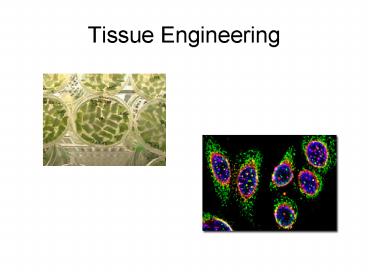Tissue Engineering - PowerPoint PPT Presentation
1 / 9
Title:
Tissue Engineering
Description:
Tissue Engineering Plant cells: current interest pharmaceuticals: atropine, codeine, L-dopa, morphine, phytotoxin (digitalis), taxol, ubiquinone-10, vincristine ... – PowerPoint PPT presentation
Number of Views:153
Avg rating:3.0/5.0
Title: Tissue Engineering
1
Tissue Engineering
2
Plant cells current interest
- pharmaceuticals atropine, codeine, L-dopa,
morphine, phytotoxin (digitalis), taxol,
ubiquinone-10, vincristine, vinblastine - colors or dyes anthocyanins, saffron, shikonin
- flavours vanilla, strawberry, grape, garlic
- fragrances jasmine, lemon, mint, rose
3
Paclitaxel (Taxol)
- anticancer drug
- extracted from bark of Pacific yew (Taxus
brevifolia) - one patient requires three 100 year old trees
- semisynthetic alternative needles and branches
of common yews, extract precursor - presently 30,000L suspension culture
4
Totipotency
- capacity to regenerate whole plants from
undifferentiated cells (common for plants) - key to micropropagation
somatic embryogenesis
5
Tissue culture propagation
root or shoot
plantlet
whole plant
cutting to solid agar development of callus
suspension culture
photobioreactor
6
Media
- sucrose as Carbon/Energy source
- inorganic nutrients
- vitamins, growth regulators
- plant hormones (auxins, cytokinins, giberellins)
- 27oC, pH 5.5 in dark
- elicitors (eg. methyl jasmonate) can cause
rapid accumulation of secondary metabolites
7
Cell characteristics
- 10 100 µm (large)
- typically nonphotosynthetic in culture (sucrose
as C/energy) - 0.5 mmol O2/h-g (5-15 that of microbes)
- high density culture possible (70 reactor
volume) - 90-95 water
- secondary metabolites often retained in vacuole
8
Suspension culture characteristics
- lower respiration rate
- shear sensitive (large cells)
- often grow as aggregates
- aggregation may be important to secondary
metabolism - CO2 or ethylene may be important
- up to 75,000L reactors have been used
9
Bioreactors
- low or moderate densities (lt20 g/L) appropriate
to airlift - high cell density require paddle or
helical-ribbon impeller - difficult balance between gas composition,
sparging rate and degree of agitation - slow growth rate so contamination is problem































